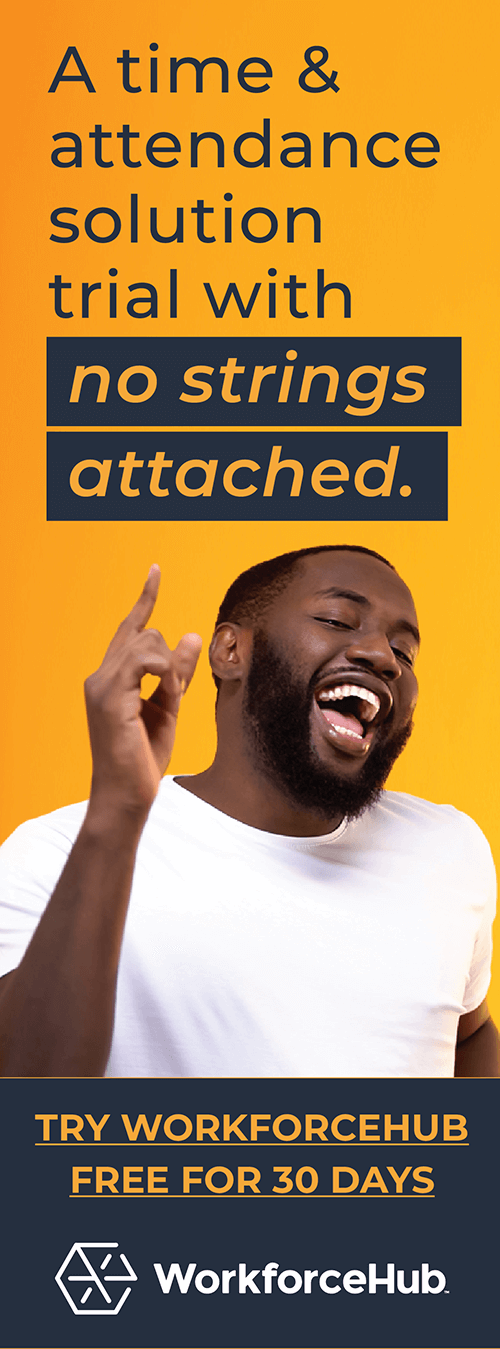HRMS Success: How to Manage Human Resources

Because small businesses have unique challenges, they need a Human Resources Management System intentionally designed for their needs. Not simply a scaled-down version of enterprise workforce management tech.
We all expect software to have an intuitive user interface. That said, HR tech has a reputation of user-unfriendliness. Small business HR departments shouldn't assume a product is going to work as well as the project management and collaboration tools they are already using. If you are in the market for an HR system, take advantage of free trials to see if the product lives up to the marketing claims.
Accurately tracking employee time is a foundational process for every business and the process used is integral to the employee experience. A straightforward, uncomplicated, and transparent process helps employees focus on their responsibilities. An inaccurate or confusing method wreaks havoc at all levels.
HR inefficiency has an outsized impact because labor and benefits take the biggest share of the budget. An HRMS can help you operate leaner than ever before. Significantly reducing or completely eliminating the repetitive and mundane actions that every human resources employee is tasked with on a daily basis is the ultimate dream.
What is Human Resources Management?
Human Resources is the umbrella term for all employee-related processes. It includes the following functions (note that this is not an exhaustive list):
- Recruiting and hiring
- Employee onboarding
- Time and attendance
- Employee scheduling
- Payroll
- Training and development
- Performance management
- Benefits management
Human Resources Management (HRM) has a profound effect on the performance of the company.
What is an HRMS System?
A Human Resources Management System (HRMS) is a suite of integrated software tools that perform Human Resources tasks. The tools allow you to automate many HR processes in the employee life cycle. Whether the task is done daily or once a year, the HRMS performs and documents the actions. The various modules and tools share information and may sync with other systems such as your payroll software.
An HRMS can automate tasks that managers, administrators and employees previously manually. Digital documents replace paper forms and file cabinets. Templates streamline repetitive processes. Employees complete documents online, verify with e-signature and perform HR tasks in the system without needing an administrator.
The Importance and Benefits of Human Resources Management Software
Analytics for Better, Deeper Workforce Insights
A Human Resources Management System tracks metrics that enable HR leaders, owners and managers to make better decisions. HR metrics are Key Performance Indicators (KPIs) that quantify how well a company is optimizing their human capital. This is analyzed in the context of overall business performance. Tracking HR metrics with HRMS software provides actionable data in near real time.
Human Resources teams can track metrics related to hiring, compensation, time and labor, scheduling, training, engagement and retention.
Improved Employee Engagement
When you automate routine processes, your employees can focus on their actual job duties. When HR software works as well as the apps employees use to manage their lives, you strengthen your brand as an innovative, forward-thinking company.
Furthermore, administrators save time with Human Resource Management software because they don’t have to personally respond to these requests. This allows them to work on higher impact activities.
3 Key Findings About Employee Engagement and Retention
- 91% of employees say the last time they left an employer, it was voluntary. (Gallup, State of the American Workplace)
- The top reasons given by employees for leaving their jobs include lack of career development (22%), lack of support with work-life balance (12%), their manager’s behavior (11%), unsatisfactory compensation and benefits (9%), and poor well-being (9%). (Work Institute)
- 87% of workers expect their company to support them in balancing their life between work and personal commitments. (Glassdoor)
Process Efficiency
Regardless of your business type, your Human Resources department is in the business of paperwork. There are applications, tax forms, benefits enrollment documents, timesheets, and employee handbooks, to name a few.
If you are a small business owner who doesn’t have an HR department, you are probably handling paperwork yourself. Did you know that most small business owners spend a quarter of their time managing administrative paperwork?
Switching to Human Resources Management software with electronic document management increases efficiency significantly. Let’s discuss some key ways a small business uses an HRMS to improve efficiency:
- Access documents anytime, anywhere with any internet-connected device
- Find records with a 2-second database search instead of digging through a file cabinet
- Allow multiple parties to work in the same documents which are updated in real time–you don’t have to wonder whether you are working on the latest version
- Eliminate redundancies and duplicated work
- The HRMS vendor handles security and software updates
- Simplify processes for off site employees and support hybrid work schedules
Culture of Self-Service
Employee Self-Service (ESS) is one of the important HRMS benefits. ESS makes HR confidential and hassle-free for your team. Employees can update their personal information and direct deposit details, make changes to benefits, request time off, review their timesheet, pull up pay stubs, and even submit reimbursement receipts.
In addition, employees appreciate the convenience of managing HR tasks outside of work hours. For example, they can request time off while they are at home planning a vacation or download pay stubs while they are applying for a loan.
Lower Back-End Overhead
Cloud-based Human Resources Management software is also called SaaS (Software as a Service). Your software vendor houses the software on their servers, performs the updates and provides security. Most providers have a minimal upfront fee. Once implemented, it works like a subscription service – customers pay a monthly fee to use the software.
The SaaS model has many advantages over Legacy systems. Firstly, a small business can use the latest technology without the expense of a custom-built application. Secondly, it has a relatively quick set-up. Thirdly, since the HRMS vendor keeps the data safe, it relieves the business owner of the weighty responsibility of security. Plus, vendors provide IT support.
Faster Recruiting and Hiring
HRMS hiring tools allow you to quickly and painlessly sift through applications, bringing the best qualified people to your attention and automatically rejecting unqualified candidates. You can create screening questionnaires with elimination questions, and ‘wrong’ responses will remove the applicant from the candidate pool (while automatically sending a thoughtfully-worded email thanking them for applying). Some HRMS go a step further, allowing you to assign value points to each question so you can sort candidates by their score.
The Functions and Components of an HRMS System
Recruiting, Applicant Tracking and Hiring
Job Posting: When you have a job opening, you want to get the word out as fast as possible. HRMS hiring tools are (also called applicant tracking systems) allow you to post jobs to multiple sites from within the software. This includes social media sites and your careers page. This saves the time and hassle of logging into each job board separately. In addition, you can compare the performance of various job boards to identify the most effective hiring channels
Candidate Management: Human Resource Management software can automatically update candidates through email or text. Create a library of email templates. The system will populate the candidate’s name, the position and other pertinent info. You can even sync an email to each hiring stage and the system will automatically send the appropriate message based on the candidate’s status.
Once you’ve narrowed down your applicant pool, the applicant tracking system eliminates the back-and-forth of interview scheduling. The HRMS presents each candidate a calendar with open slots for interviews. The hiring manager (and others on the hiring panel) enter the times they are available, and the interviewee selects the slot that works best. No more email or phone tag!
Structured interviews and standardized scoring minimize bias and help hiring managers more effectively evaluate candidates. HRMS software stores interview scripts for multiple job postings. You can customize candidate scorecards for everyone on the interview panel. During the interview, each member of the panel fills out a scorecard. The software tallies the results and the hiring manager can sort candidates by score.
Employee Onboarding
Onboarding is a critical process that affects everything from employee performance to retention. High turnover is one of the stickiest problems in the current employment climate. Firms with effective onboarding processes experience less turnover. Here are some key onboarding features:
- Online portal for new hire paperwork
- E-signature
- Completion confirmation
- Real-time analytics and reporting
- WOTC application and filing
- Background and reference checks
Employee Timekeeping and Scheduling
Employee Scheduling: Great scheduling ensures you have the right people with the right skills for each shift. Human Resources Management software streamlines each part: creating schedules, publishing schedules, handling changes and complying with applicable laws.
In addition, scheduling is synced to PTO. Schedulers can see which employees have time off when they plan shifts. This prevents coverage gaps and schedule confusion.
Attendance and Absenteeism: Another one of the benefits of HRMS is the fact that the schedule builder is synced to a time clock or web-based clocking portal. Punching in is smooth and easy for employees–whether they are in the office, at home or on the road. The HRMS timekeeping module accurately tracks hours so your employees don’t have to fill out paper timecards—which has long been the bane of hourly employment.
The HRMS software reminds employees of missed punches so they can fix them before payday. Another one of the benefits of HRMS is easy manager approvals. Managers have all timecards and PTO requests in the same system, each with a date stamp.
An HRMS system helps prevent absenteeism in multiple ways. First, you can post schedules early and employees can access them from any mobile device 24/7. Secondly, the scheduling tool shows the dates of approved leave. This allows the schedule builder to plan shifts with all pertinent information. Thirdly, when an employee calls out, the manager can pull up a dynamic list of available employees to cover. Fourthly, managers can track employee preferences in the schedule builder.
Time-Off Management: When an employee wants to request time-off, they can see how many hours they have accrued and if any other employees are on leave during the desired vacation time. They submit the request to their manager through the software.
Consequently, managers can see all requests in a centralized location. This makes it easier to know how leave will impact schedules and projects.
Talent Management
Learning Management: As mentioned previously, job seekers are looking for employers that provide training and development. HR software allows you to administer training programs and certifications. The module that handles this is called a Learning Management System or LMS. Employers can create e-learn courses, monitor participation and track progress.
Performance Management: Every business needs to take the time to evaluate employees, provide constructive feedback, and consider how each employee contributes to company goals. Employers are moving away from the yearly review to more frequent assessments. Human Resources Management software has tools for frequent check-ins, goal-setting and progress tracking.
Employee Information System and Self-Service: Employees can access all of their HR data in the system. These include contact information, paycheck direct deposit, timesheets, pay stubs, the employee handbook, and performance reviews.
Analytics and Informed Decision-Making: HRMS analytics and reporting let business owners track workforce KPIs in real time. This allows employers to spot trends early, maximize their labor spend, and plan for the future.
Offboarding: An HRMS solution helps you revoke credentials to software and online accounts, administer COBRA, re-assign job responsibilities, and reconcile unused PTO.
HR Management
Employee Engagement: A Human Resources Management System helps you create and administer recognition and rewards programs, an anonymous suggestion portal, employee surveys and other engagement programs.
Gathering, Storing and Accessing Employee Information: Electronic document management is a must-have for a modern workforce. Features include digital documents, near-instant database searches, and cross-module document sharing.
Payroll Management: Payroll is at the heart of HR. Tracking hours, accruals and issuing paychecks is more accurate and efficient with an HRMS system.
Benefits Administration: Store benefits information and update when necessary, provide around-the-clock access, and allow employees to make changes on their own.
HRIS, HRMS, HCM, What’s the Difference?
There is much overlap in the alphabet soup of workforce management technology. In general, a Human Resources Information System (HRIS) focuses on employee data and core HR processes. Early systems merged Human Resources data with information technology systems, hence the ‘Information System’ in the name.
While an HRMS includes everything in an HRIS, it also contains features of strategic HR including hiring, employee engagement, and performance management.
A Human Capital Management (HCM) system expands to include talent pipeline management, offboarding, succession planning, and compensation management. In other words, an HCM platform handles everything in the employee lifecycle from hire to retire.

Photo by Jason Goodman on Unsplash
Benefits to Employees
Let’s look at how an HRMS benefits employees.
Employee Onboarding: Nothing results in success like a carefully-executed onboarding experience. With an HRMS, you can create an onboarding process on par with the most innovative businesses. Allow employees to complete new hire paperwork at their convenience from any connected device. Administrators receive a completion confirmation when each document is submitted.
Benefits Enrollment: Employees compare plans, enroll, and sign forms in the portal. Centralized management and e-signature streamline what used to be a confusing and tedious process.
In all the years I’ve been in HR, I’ve never encountered a person who didn’t want to fully utilize their benefits. They simply didn’t understand how to navigate the complexity or how all the benefits worked. Zach Montroy, SPHR
Time and Attendance: With an HRMS system that tracks work time to the minute, employees know they will be paid extra when they come in early or stay late. They have confidence that overtime and accruals are tracked accurately. If benefits eligibility depends on full-time status, HR software can validate work hours. Payroll accountability brings peace of mind to your team.
Employee Scheduling: With an HRMS, employees can see their schedule, swap shifts, request time off, and manage FMLA in the portal. It improves work/life balance by making it easier for managers to accommodate schedule preferences. It takes the hassle out of shift trading. When a shift opens up, employees who want extra hours can request it. This eliminates the need for a manager to beg unwilling employees. Part-time employees can better juggle two jobs when their employers use HRMS scheduling.
Productivity: HRMS with employee performance dashboards are popping up in many industries. When employees can see the big picture, they can better understand how their role contributes to the success of the company as a whole. Real-time feedback is a powerful motivator. It can make tedious jobs more interesting and interesting jobs even more enjoyable.
Mobility: Human Resources Management system apps give employees 24/7 access and convenience. Modern, easy to use mobile tools help you engage and retain increasingly tech-dependent employees.
Career Paths: An HRMS system helps you create a career paths program and manage performance reviews. Opportunities for advancement have never been more important to employees.
78% of employees said they would remain longer with their employer if they saw a career path within the current organization.
Oversight: Your managers are an important part of your workforce. Let’s discuss HRMS benefits for managers. Team oversight is a priority, but it can be challenging even when all employees are in the same office. Managers with mobile, offsite, or remote employees have even greater challenges. An HRMS mobile app allows managers to monitor teams from a smartphone or tablet. Overtime alerts, missed punch notifications and geofencing help supervisors ensure the right people are working at the right time in the right places.
Timecard Approvals: Human Capital Management software creates digital timecards. The hours are tallied with each shift. Managers have all timecards in a centralized location, so they don’t need to collect them from their employees.
PTO Requests: Confusion surrounding time off is a common problem. Without a formal system, managers are at risk of scheduling employees who are on vacation or forgetting someone’s request. Employees request time off with the HRMS PTO tool where they can see how much time they have accrued. Managers can see all the requested dates together, side by side. It is a great way for managers to outsource their memory and treat all employees fairly when it comes to vacation time. This removes any actual or perceived inequity.
Schedule Building: Create schedules in minutes with templates and drag-and-drop tools. The system finds eligible employees to cover open shifts. View schedules by team, by week, or by location.
An HRMS reduces manager scheduling time by up to 70%. (Plus it removes 100% of the hassle!)

Photo by Christina Morillo on Pexels
Assessing the Need for an HRMS: Answer These 5 Questions
All sizes of businesses in all industries can benefit from an integrated HR system. Though no two businesses are the same, they all have employees to manage. HRMS software enables employers to optimize their HR processes to ensure their workforce can achieve their business goals.
1. How Many Employees Do I Have?
The regulatory burden increases as your workforce grows. All employers are subject to the Fair Labor Standards Act (FLSA). When you hire your 11th employee, you are subject to the Occupational Safety and Health Act (OSHA). At 15+, the Americans with Disabilities Act (ADA) kicks in. When your staff hits 51, the Affordable Care Act (ACA) applies.
An HRMS is the best tool for managing compliance.
2. Are We Growing Quickly?
Though it’s a great problem to have, you’re especially vulnerable to problems when expanding quickly.
Human Resources Management software can help you manage rapid business growth. You will need to ramp up hiring. Quality of talent is critical.
Payroll becomes more complicated. Unmanaged overtime can sink your labor budget. It’s more difficult to prevent time theft. Manual paperwork becomes overwhelming.
A good HRMS will prevent lapses in productivity as you scale up. Furthermore, it will help you create processes that will accommodate your pace of growth indefinitely.
In other words, Human Resources Management software will not only prevent problems, it will fuel your growth.
3. Is My HR Team Overwhelmed?
Is your admin staff scrambling to stay on top of everything? Are employees frustrated because HR is slow to respond? You give your other employees the tools they need, don’t shortchange your hard-working Human Resources professionals.
When HR can automate tedious, repetitive tasks, they can use their time on projects that have a greater impact. For example, better onboarding, formalized career paths, and employee engagement programs.
Take care of your HR team and they will take care of your employees.
4. Do I Lose Too Many Employees?
Do you have a high turnover rate? You need to improve your company culture. A capable HR director can use Human Resources Management software to turn things around.
Haven’t any idea if your turnover rate is high or not? Take that as a sign you need an HRMS to track data and present it in an easy-to-understand format. HR metrics matter. You can’t improve things until you figure out what’s going on.
5. Are My Operating Expenses Spiraling Out of Control?
Many operating expenses are fixed. A five-year lease on office space, for instance. Administrative costs, however, are variable. Inefficiency has an outsized impact because labor and benefits take the biggest share of the budget. An HRMS can help you operate leaner than ever before.
There is absolutely no reason why your HR team should be tied up with tedious data entry and administrative tasks when they have much larger fish to fry, such as enhancing the company culture, improving benefits, and strengthening employee relations and satisfaction.
An HRMS system is the perfect solution to address those smaller tasks and allow your HR department to focus on what truly matters. Plus, an HRMS will give your company the momentum it needs to scale quicker by improving workplace efficiency.
Enterprise Businesses
Enterprise businesses have unique but well-defined processes. An HRMS benefits the people ops in every department and location. Administrators can customize various modules to meet their needs. For example, international hiring teams can track and manage hundreds of candidates simultaneously. Each manager can customize time and attendance tools for their team (hourly vs. salaried, for example). Benefits administrators can manage country-specific insurance plans for a global workforce.
Another way an HRMS benefits enterprise organizations is to decrease the risk of a compliance violation. Enterprise employers have FMLA (Family and Medical Leave Act), ACA (Affordable Care Act), and FLSA (Fair Labor Standards Act) overtime and minimum wage obligations.
SMBs: The Benefits of HRMS for Small Businesses
Paperless Onboarding: New hires that experience an online, hassle-free onboarding process have the best chance for success and are more likely to stay with the company long-term. Digital onboarding also reduces the administrative burden for small teams. This includes HR departments of one and employees who manage HR in addition to other tasks.
Employee Self-Service (ESS): As previously discussed, ESS improves engagement, strengthens the employer brand (which helps in attracting talent) and saves time and effort for administrators.
Better Workforce Management: Intelligent automation with Human Resources Management software streamlines and simplifies hundreds of HR workflows from job posting to scheduling to payroll.
Improved KPI Monitoring: Tracking analytics with spreadsheets is time-consuming and error-prone. And many SMBs don’t have the staff necessary to manage it. Human Resources Management software captures workforce data in real time. This allows business owners to optimize processes and maximize their labor spend.
Clear Communication: Communication has always been important but has become more complicated with hybrid work schedules, mobile employees and asynchronous collaboration. An HRMS provides a system of record for hundreds of documents and processes. All employees have access to necessary information and the system updates it automatically. The software also has instant messaging features and task reminders which help keep everyone in the loop.
Support Your Decisions With Evidence: With Human Resource Information system metrics, you can make better business decisions. For example, which job boards deliver the best candidates, which teams have the most overtime, and labor costs per project.
Tips for Successful HRMS Implementation
Introducing a new HRMS is a no-brainer, but that doesn’t mean you won’t run into a few speed bumps on your road to implementation. For detailed instructions including how to obtain buy-in and creating a rollout timeline, visit 10 Tips for a Successful HRMS Implementation.
HRMS Security
It cannot be overstated that your employee’s personal data must be protected. There are multiple laws that govern data security and privacy, and security breaches can destroy your culture.
Essential features of HRMS data security include:
Role-based access and system segmentation: Each user should only have access to what they need to do their jobs. If they need to access something more sensitive for a short period of time, their login privileges should be withdrawn as soon as they are finished. For example, the tech support team may not need access to the CRM system.
Two-factor authentication: This is easy to set up, especially if each employee has a cell phone. It provides increased protection for both the user’s credentials as well as the systems the user can access.
Data encryption: Because unencrypted data is vulnerable to breaches, an HRMS system should encrypt all HR information when not being used. An authorized user needs an encryption key to convert the data to usable plaintext.
Password strength and reset policies: The system should accommodate best practices for password length and frequency of reset.
History of HRMS
Oracle PeopleSoft was the first client-server based HR solution. In the early nineties, vendors started introducing the first ERP-HR applications while payroll software providers started adding workforce management features.
The HRMS market came into its own in the early 1990s as HRMS ERP vendors such as Oracle and JD Edwards introduced HR ERPs which were designed to cover all HR functionality, including core HR, recruiting, learning, U.S. payroll, and reporting. The 1990s also saw a shift away from client-server technology and onto the web, an innovation that removed the need for software to be installed locally. In doing so it opened up HRMS systems to users outside of HR, such as managers and employees, opening the door to HRMS employee self-service. The HRMS landscape continues to develop as vendors provide new options and functionality to meet the evolving needs of HR. HRMS World
Up until the 2000s, only companies with a large tech budget could afford custom HR software housed on company servers. Legacy software required a large upfront fee and professional installation.
The emergence of cloud computing in the late nineties and early 2000s made HRMS solutions affordable for SMBs. Cloud computing also paved the way for the SaaS model. In the 2010s, employee self-service and mobile apps became HRMS staples.
During the pandemic, cloud-based HR tech adoption surged as remote working made it more difficult to manage employees with outdated software. A global 2021 ISG (Information Services Group) survey found 46% of respondents reported using a SaaS HR platform and 57% planning to adopt one before 2023.
Conclusion
In summary, companies that want to maximize their human capital will choose a capable HRMS:
- Your business will grow faster
- Human Resources management will be as efficient as possible
- It will be easier to maintain compliance with workplace laws
- Your employees will happier, more engaged, and more likely to stay with your company
WorkforceHub from Swipeclock is the unified time and labor system tailored to and created for small businesses.
See also:
- Employee Time Clock Hardware
- 9 Ways Workforce Management Helps Employees Love Their Jobs
- Best Employee Time Tracking System to Replace Punch Card Clock
- Improve Employee Relations With 7 Strategies [Remote & Onsite]
- Create a Career Paths Program in 7 Steps [or Lose Your Best Employees)
- Predictive Scheduling Laws: What You Need to Know
- 7 Ways an HR Portal Can Transform Your Business
- 5 Practical Tips for Managing Your Hybrid and Onsite Workforce
- Destructive Employee Absenteeism: Improve Your Attendance Tracking
- 8 Employee Time Tracking Tools for High Performing Businesses
Updated September 2, 2022
Simplify HR management today.
Simplify HR management today.
Navigating the Complexities of Healthcare Recruitment
The healthcare sector is renowned for its rewarding nature, offering professionals the chance to significantly impact individuals’ lives by aiding in their recovery from various ailments and conditions. However, for those tasked with recruitment within this sector, the challenges are plentiful. Delve into our in-depth guide for an array of strategies to elevate your healthcare…
Read MoreHow Improving Candidate Engagement Influences the Hiring Process
Applicants invest considerable time, effort, and thought into their job applications. Regrettably, it’s all too common for employers to delay responses, with some failing to provide any follow-up whatsoever. Such practices can have a negative effect on the candidate experience, influencing your organization’s hiring efficiency and reputation. Ensuring a positive experience for candidates is crucial…
Read More





